Linlithgow Palace
The ruins of Linlithgow Palace are situated in the town of Linlithgow, West Lothian, Scotland, 15 miles (24 km) west of Edinburgh. The palace was one of the principal residences of the monarchs of Scotland in the 15th and 16th centuries. Although maintained after Scotland's monarchs left for England in 1603, the palace was little used, and was burned out in 1746. It is now a visitor attraction in the care of Historic Environment Scotland.
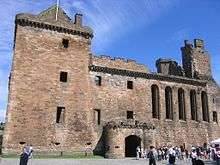

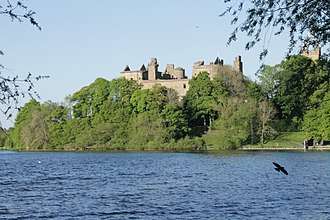

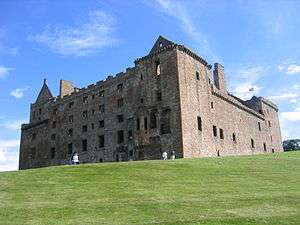


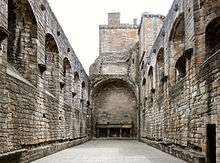
History
A royal manor existed on the site in the 12th century.[1] This was replaced by a fortification known as 'the Peel', built in the 14th century by occupying English forces under Edward I. The site of the manor made it an ideal military base for securing the supply routes between Edinburgh Castle and Stirling Castle. The English fort was begun in March 1302 under the supervision of two priests, Richard de Wynepol and Henry de Graundeston. The architect, Master James of St George, was also present.[2] In September 1302, sixty men and 140 women helped dig the ditches; the men were paid twopence and the women a penny daily.[3] One hundred foot-soldiers were still employed as labourers on the castle in November and work continued during the Summer of 1303.[4]
In September 1313, Linlithgow Peel was retaken for Scotland by an ordinary Scot named William Bunnock who was in the habit of selling hay to the garrison of the peel. When the gate was opened for him, he halted his wagon so that it could not be closed, his eight compatriots leapt out from their hiding place under the hay, and they captured the peel for King Robert the Bruce. King Robert sent reinforcements and had the peel dismantled so that it could not be retaken by the English.[5]
In 1424, the town of Linlithgow was partially destroyed in a great fire.[6] King James I started the rebuilding of the Palace as a grand residence for Scottish royalty, also beginning the rebuilding of the Church of St Michael immediately to the south of the palace: the earlier church had been used as a storeroom during Edward's occupation.[7] Over the following century the palace developed into a formal courtyard structure, with significant additions by James III and James IV. James V was born in the palace in April 1512, the household of his mother Margaret Tudor at Linlithgow included the African servants Margaret and Ellen More.[8] In April 1513 the roof of the chapel was altered and renewed, and a new organ was made by a French musician and craftsman called Gilyem and fixed to the wall. Timber was shipped to Blackness Castle and carted to the Palace. The windows of the queen's oratory, overlooking the Loch, were reglazed.[9]
James V added the outer gateway and the elaborate courtyard fountain.[10] The stonework of the South façade was renewed and unified for James V in the 1530s by the keeper, James Hamilton of Finnart.[11] The older statues of the Pope, the Knight, and Labouring Man on the east side of the courtyard, with the inscriptions on ribbons held by angels were painted.[12] Mary, Queen of Scots, was born at the Palace in December 1542 and occasionally stayed there during her reign.[13]
James VI of Scotland came to Linlithgow in May 1583, and his courtiers, including the Earl of Bothwell and the Earl Marischal played football.[14] James VI held a parliament in the great hall of the palace in December 1585, the first gathering of the whole nobility in the palace since the reign of his grandfather James V of Scotland.[15] James VI gave lands including the palace to his bride Anne of Denmark as a "morning gift". On 14 May 1590 Peder Munk, the Admiral of Denmark, rode to Linlithgow from Niddry Castle, and was welcomed at the palace by the keeper Lewis Bellenden. He took symbolic possession or (sasine) by accepting a handful of earth and stone.[16] The next keeper was the English courtier Roger Aston, who repaired the roof in 1594 using lead shipped from England.[17] Roger Aston was of doubtful parentage and as a joke hung a copy of his family tree next to that of the king of France in the long gallery, which James VI found very amusing.[18]
The daughter of James VI and Anna, Princess Elizabeth lived in the Palace in the care of Helenor Hay, Countess of Linlithgow.[19] After the Union of the Crowns in 1603 the Royal Court became largely based in England and Linlithgow was used very little. The old North Range, described as 'ruinous' in 1599, collapsed on 6 September 1607, and The 1st Earl of Linlithgow wrote to King James VI & I with the news:
Please your most Sacred Majestie; this sext of September, betuixt thre and four in the morning, the north quarter of your Majesties Palice of Linlithgw is fallin, rufe and all, within the wallis, to the ground; but the wallis ar standing yit, bot lukis everie moment when the inner wall sall fall and brek your Majesties fontane."[20]
King James had it rebuilt between 1618 and 1622. The carving was designed by the mason William Wallace. In July 1620, the architect, James Murray of Kilbaberton, estimated that 3,000 stones in weight of lead would be needed to cover the roof, costing £3,600 in Pound Scots (the Scottish money of the time).[21] On 5 July 1621 the then Earl of Mar wrote to James to tell him he had met Murray and viewed the works at 'grate lenthe.' He said the Palace would be ready for the King at Michaelmas.[22] The carving at the window-heads and the Royal Arms of Scotland were painted and gilded. and the old statues of the Pope, Knight, and Labouring Man on the east side had also been painted.[23] However, the only reigning monarch to stay at Linlithgow after that date was King Charles I, who spent a night there in 1633.
In 1648, part of the new North Range was occupied by The 2nd Earl of Linlithgow.[24] An English visitor in October 1641 recorded in a poem that the roof of the great hall was already gone, the fountain vandalised by those who objected on religious grounds to the motto "God Save the King," but some woodcarving remained in the Chapel Royal.[25]
The palace's swansong came in September 1745, when Bonnie Prince Charlie visited Linlithgow on his march south but did not stay overnight. It is said that the fountain was made to flow with wine in his honour.[26] The Duke of Cumberland's army destroyed most of the palace buildings by burning in January 1746.
Keepers and Captains of the Palace
The positions of official keeper and captain of the palace have been held by; James Hamilton of Finnart, 1534, Captain and Keeper; William Danielstoun from 19 November 1540; Andrew Hamilton in Briggis, from 22 August 1543; Andrew Melville of Murdocairney, later Lord Melville of Monimail, brother of James Melville of Halhill, from 15 February 1567; George Boyd, deputy Captain, 1564; Andrew Ferrier, Captain of the Palace, 1565, Frenchman; John Brown, June 1569; Andrew Lambie, June 1571; Ludovic Bellenden of Auchnoul 22 November 1587, and 1595 Roger Aston. The office was acquired by Alexander Livingstone, 1st Earl of Linlithgow, and remained in that family until 1715 when the rights returned to the Crown.[27]
Present day
The palace has been actively conserved since the early 19th century and is today managed and maintained by Historic Environment Scotland. The site is open to visitors all year round, usually subject to an entrance fee for non-members, but on occasion the entry fee is waived during the organisation's "Doors open days".[28] In summer the adjacent 15th-century parish church of St Michael is open for visitors, allowing a combined visit to two of Scotland's finest surviving medieval buildings. The site was visited by 94,718 people in 2018.
For over 40 years, tours of the palace for children are lead by 'Junior Guides', pupils at Linlithgow Primary School [29]
A Strathspey for bagpipes was composed in honour of Linlithgow Palace.[30]
The Palace is said to be haunted by the spectre of Mary of Guise, mother to Mary, Queen of Scots.[31]
Artistic and cultural uses
On 4 December 2012, the French fashion house Chanel held its tenth Métiers d’Art show in the palace. The collection, designed by Karl Lagerfeld, was called 'Paris-Édimbourg' and inspired by classic Scottish styling using tweed and tartan fabrics worn by models Stella Tennant, Cara Delevingne, and Edie Campbell.

The show renewed media interest in the possibility of restoring the roof of the palace.[32]
In August 2014, a music festival was held on the palace's grounds called 'Party at the Palace'. This became a yearly event and again took place in 2015; from 2016 it was moved to the other side of the loch due to its popularity and need for more space. The festival still boasts views of the palace.
Some scenes in the time-traveling romance TV series Outlander are set at a fictional castle for which Linlithgow Palace stands in; this has attracted a number of international tourists.[33]
References
- "Linlithgow Palace: Property detail". Historic Scotland.
- Notices of Original Documents illustrative of Scottish History, Maitland Club, (1841), 67-83, (headings only).
- Accounts of the Master of Works, vol. 1 (Edinburgh, 1957), p. lxvi (Latin).
- Simpson, Grant, & Galbraith, James, ed., Calendar Documents Scotland in PRO and British Library, vol. 5 supplementary, SRO (n.d), no. 305, no. 472 (h, j, u), 'j' mentions Robert de Wynpol (Wimpole) working in Summer 1303, 472 (k) mentions the Warwolf lupus-guerre siege engine at Stirling Castle.
- Scott, Ronald McNair (1982). Robert the Bruce, King of Scots. Edinburgh, Scotland: Cannongate Publishing. p. 133.
- British Castle - Linlithgow Palace History
- "St Michael's Church Feature Page". Undiscovered Scotland. Retrieved 6 August 2009.
- Accounts of the Lord High Treasurer of Scotland, vol. 4 (Edinburgh, 1902), pp. 339, 324, 401, 404.
- Accounts of the Lord High Treasurer of Scotland, vol. 4 (Edinburgh, 1902), pp. 442, 523-5.
- John G. Dunbar, Scottish Royal Palaces (Tuckwell/Historic Scotland/RCAHMS: East Linton, 1999), pp. 6-21.
- Henry Paton, Accounts of the Masters of Work: 1529-1615, vol. 1 (Edinburgh, 1957), pp. 115-131.
- Accounts of the Masters of Work, vol. 1 (Edinburgh, 1957), p. 128.
- "Mary, Queen of Scots (r.1542-1567)". The official website of the British Monarchy.
- Miles Kerr-Peterson, A Protestant Lord in James VI's Scotland: George Keith, Fifth Earl Marischal (Boydell, 2019), p. 32: William Boyd, Calendar of State Papers Scotland: 1581-1583, vol. 6 (Edinburgh, 1910), p. 475.
- Calendar State Papers Scotland, vol. 8 (Edinburgh, 1914), p. 161.
- David Stevenson, Scotland's Last Royal Wedding (John Donald: Edinburgh, 1997), p. 103.
- Miles Kerr-Peterson & Michael Pearce, 'James VI's English Subsidy and Danish Dowry Accounts', Scottish History Society Miscellany XVI (Woodbridge, 2020), pp. 79, 87.
- Joseph Bain, Calendar of Border Papers, vol. 2 (Edinburgh, 1894), pp. 563
- Register of the Privy Council of Scotland, vol 10 (Edinburgh, 1891), p. 521.
- The Spottiswoode Miscellany, vol. 1 Edinburgh, (1844), 369: Calendar State Papers Scotland vol. 13 part 2 (Edinburgh, 1969), p. 623.
- Register of the Privy Seal of Scotland, vol. 12 (Edinburgh, 1895), p. 335.
- HMC Mar & Kellie at Alloa House (London, 1904), pp. 95-86.
- Mackechnie, Aonghus, 'James VI's Architects' in, The Reign of James VI (Tuckwell, 2000), p. 168.
- The Spottiswoode Miscellany, vol. 1 (1844), pp. 370-372.
- Miscellany of the Scottish History Society, 2, (1904), 275, anonymous poem, A Scottish Journie of Montague Bertie, Lord Willoughby.
- "'Wine' fountain to flow once more". BBC News. 26 June 2007.
- The Spottiswoode Miscellany, vol. 1 (Edinburgh, 1844), p. 355: Protocol book of Thomas Johnson (SRS, 1920), nos. 340, 709, 781, 839, 864.
- "Free weekend". Historic Scotland.
- "Historic Environment". www.historicenvironment.scot. Retrieved 28 August 2019.
- Archie Cairns - Book 1 Pipe Music 'Linlithgow Palace' Strathspey 1995
- "Haunted trail of Mary, Queen of Scots - Scotsman.com News". The Scotsman. 8 December 2005.
- Chanel Paris-Edimbourg Archived 11 April 2013 at Archive.today: Vogue Metiers d'Art: Scotsman Newspaper, 3 March 2013, 'Roof for Linlithgow'
- Baynes, Richard (15 February 2020). "'Outlander' TV Show Prompts Tourist Boom In Central Scotland". Weekend Edition Saturday. Retrieved 16 February 2020.
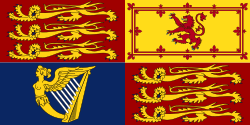
.svg.png)